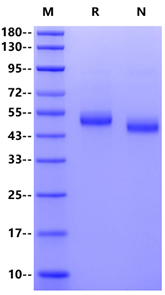Lys26-Pro396, with C-terminal 8*His KKVVLGKKGDTVELTCNASQKKNTQFHWKNSNQIKILGIQGSFLTKGPSKLSDRADSRKSLWDQGCFSMIIKNLKIEDSDTYICEVENKKEEVELLVFGLTANSDTHLLEGQSLTLTLESPPGSSPSVKCRSPGGKNIQGGRTLSVPQLERQDSGTWTCTVSQDQKTVEFKIDIVVLAFQKASSTVYKKEGEQVEFSFPPAFTLEKLTGSGELWWQAERASSSKSWITFDLKNKEVSVKRVTQDPKLQMGKKLPLHLTLPQALPQYAGSGNLTLALEAKTGKLHQEVNLVVMRATQFQENLTCEVWGPTSPKLTLSLKLENKGTTVSKQAKAVWVLNPEAGMWQCLLSDSGQVLLESNIKVVPTWPTPVQPGGGSHHHHHHHH
48-54kDa
Reconstitute at 0.1-1 mg/ml according to the size in ultrapure water after rapid centrifugation.
1、Owen G R. et al. (2016) Human CD4 Metastability Is a Function of the Allosteric Disulfide Bond in Domain 2. Biochemistry. 55(15): 2227-2237.
The cluster of differentiation 4 receptor (CD4) is a 55kDa type I integral membrane glycoprotein which plays a substantial role during adaptive immune responses. In T-cells, CD4 mediates maturation, stabilizes T-cell receptor interactions with peptide-major histocompatibility complex class II (MHCII) complexes on antigen presenting cells, and mediates intracellular T-cell signalling.2 In addition to T-cells, CD4 has also been shown to be expressed on monocytes, monocyte-derived macrophages, Langerhans cells, B lymphocytes, dendritic cells, eosinophils, megakaryocytes and mast cells. The role of CD4 during immune function can also be diverted by the human immunodeficiency virus type 1 (HIV-1) envelope glycoprotein gp120 as the viral receptor utilizes CD4 as the primary receptor as well as the co-receptor CCR5/CXCR4 during the entry process.


Immobilized CD4/LEU3 His Tag, Cynomolgus (Cat. No. UA010356) at 0.2μg/mL (100μL/well) can bind Anti-Human CD4 (Ibalizumab) with EC50 of 1.70-2.76ng/mL.